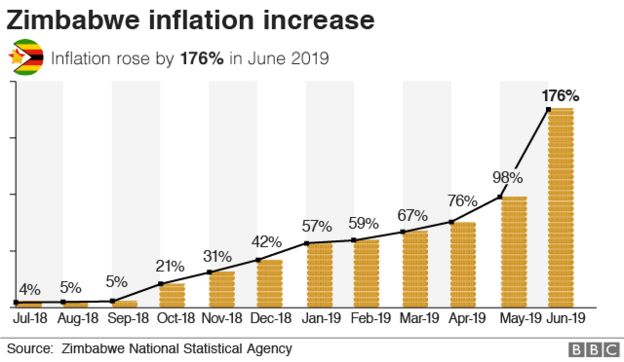Instead it has relied on the US dollar along with a local money system pegged to the dollar.
The economy is no longer in its extreme inflationary spiral, but the country has continued to suffer from severe shortages of food, medicine and fuel.
Last month, the Zimbabwean authorities reintroduced the Zimbabwean dollar as the country’s sole legal tender.
Foreign Minister Sibusiso Moyo says this move has stabilised the economy.
But is he right? Reality Check looks at the country’s key economic indicators before and after the currency was reintroduced.
Fears of a return to hyperinflation
There has been understandable concern that the return of the Zimbabwe dollar would lead to a return to the chaotic hyperinflation which destroyed savings and made wages worthless.
The most recent figures suggest inflation has risen sharply over the last year. In May it was 98% and by June, annual inflation stood at 176%.
This is nowhere near the spiralling inflation levels of a decade ago, but the trend has not been encouraging.
So the introduction of the new currency comes at a sensitive time.

There’s also debate about whether the official number accurately captures the increase in goods on shop floors and at petrol stations, for instance.
Leading economists say it’s likely the cost of living is higher than official figures indicate.
Since the introduction of the new currency on 24 June, it has fallen against the US dollar.
This benefits Zimbabwe’s agricultural exports, mainly its tobacco sector.
But any positive effects are likely to be outweighed by more expensive imports, leading to further inflationary pressures on the economy.
The weaker currency is likely to have an impact across the economy, as importers struggle to get access to foreign exchange such as the US dollar in order to buy goods from abroad.
Taking a longer term view, the government has reduced spending since October last year and is now running a budget surplus, which it says is an indication of an improving economy.
Independent economists are sceptical about these numbers.
 Harare, Zimbabwe – where the price of goods has increased
Harare, Zimbabwe – where the price of goods has increased
Falling value of salaries
Public sector workers in Zimbabwe are paid in local currency and there are fears that because of its decline against the US dollar, and because of inflation, they are now, in effect, earning less.
Zimbabwe’s main public sector workers’ union, Apex Council, said in a petition that the value of earnings has fallen “from at least $475 to a mere $47 currently for the lowest paid civil servant” since October last year.
Last week Cecilia Alexander, Apex Council chairwoman, said the government’s austerity plans had left workers mired in poverty.
Unions have, however, agreed a one-off payment of 400 Zimbabwean dollars ($45) to every worker in July, while talks on pay continue.
Post published in: Business

